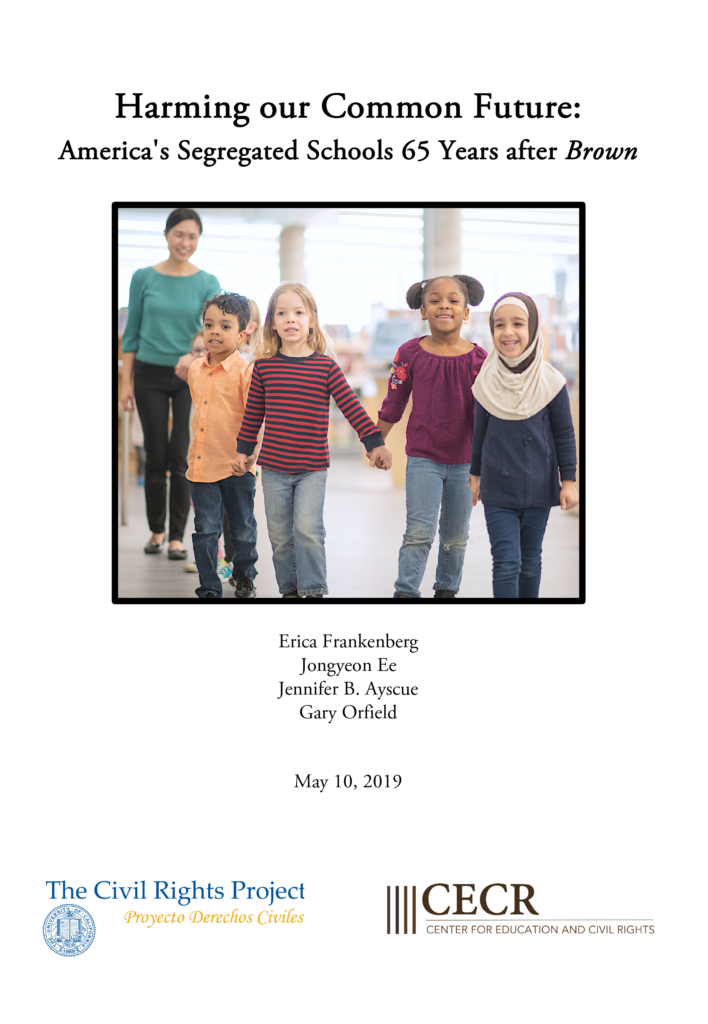EXECUTIVE SUMMARY
The publication of this report marks the 65th anniversary of Brown v. Board of Education, the landmark U.S. Supreme Court case declaring racial segregation in public schools unconstitutional. In the immediate years after the Brown ruling, the effort to integrate schools faced many difficult challenges and progress was limited. But the passage of the l964 Civil Rights Act as well as a series of Supreme Court decisions in the l960s and early 1970s produced momentum towards increased desegregation for black students that lasted until the late l980s, as districts across much of the country worked to achieve the promise of Brown–integrated schools for all children.
As we mark the 65th anniversary of Brown, there have been many changes since the ruling, but intense levels of segregation—which had decreased markedly after 1954 for black students—are on the rise once again. In the 1990s, a series of Supreme Court decisions led to the end of hundreds of desegregation orders and plans across the nation. This report shows that the growth of racial and economic segregation that began then has now continued unchecked for nearly three decades, placing the promise of Brown at grave risk.
These trends matter for students, and for communities whose futures are determined by how the public schools prepare their students for a diverse future. Research shows that segregation has strong, negative relationships with the achievement, college success, long-term employment and income of students of color. At a time of dramatic demographic transformation, the implications of these trends and research are important for us to address.
White students are now a minority across the country’s public school enrollment, and they have been for a while, particularly in the public schools of the nation’s two largest regions, the West and the South. Since 1968 the nation’s enrollment of white students has declined by 11 million students while the enrollment of Latinos has increased by 11 million. There are now nearly three million Asian students and two million students who identify as multiracial. These changes are a direct reflection of lower birth rates among white households and population growth due to immigration. Latino students were 5% of U.S. enrollment in 1970 and 26% by 2016. At this stage, the vast majority of Latino students are U.S. citizens, but the Supreme Court’s Plyler decision requires that public schools enroll all students regardless of citizenship status.
White and Latino students are the most segregated groups. White students, on average, attend a school in which 69% of the students are white, while Latino students attend a school in which 55% of the students are Latino. Segregation for black students is rising in all parts of the U.S. Black students, who account for 15% of enrollment, as they did in 1970, are in schools that average 47% black students. Asian students, on average, attend schools with 24% fellow Asians. Black students attend schools with a combined black and Latino enrollment averaging 67%, and Latino students attend schools with a combined black and Latino enrollment averaging 66%. White and Asian students have much lower exposure to combined black and Latino students, at 22% and 34%, respectively.
Suburban schools in our nation’s largest metropolitan areas had only 47% white students in 2016, a ten-percentage point decline in a decade. About a seventh of these suburban students were black, and more than a fourth (27%) were Latino. There was considerable segregation within the suburbs, where both African American and Latino students typically attended schools that were about three-fourths nonwhite. White students in these same large suburbs attended schools where two-thirds of the enrollment was white students, on average. Our book, Resegregation of Suburban Schools, showed that few of the racially changing suburbs we studied had any desegregation plans. Doing nothing means accepting resegregation.
Even rural schools that were 70% white had stark differences in segregation. The typical white student went to a rural school in which 80% of students were white, while the typical black or Latino student went to a rural school with 57% nonwhite enrollment.
New York remains the most segregated state for African American students with 65% of African American students in intensely segregated minority schools. California is the most segregated for Latinos, where 58% attend intensely segregated schools, and the typical Latino student is in a school with only 15% white classmates. These numbers, especially in California, are related in part to sweeping changes in the total population structure as well as the termination of desegregation efforts, and reflect the changing realities of classroom composition.
The federal government has no programs devoted to fostering voluntary integration of the schools, aside from the small Magnet School Assistance Program. It has been decades since federal agencies funded significant research about effective strategies for school integration. Encouragingly, there are efforts for integration under state law and policies now in process in several states. Additionally, court-ordered and Office for Civil Rights-negotiated desegregation plans remain in a few hundred smaller districts, and there are dozens of local districts and regional desegregation efforts as well. We end with recommendations that research has shown can help achieve the promise of Brown, and that sharply reduce the number of segregated schools the Court described as “inherently unequal.”
In compliance with the UC Open Access Policy, this report has been made available on eScholarship: escholarship.org/uc/item/23j1b9nv
